Strand7's automatic mesher: soon to be launched
December 2000
Since late last year, Allyson Lawless, the well-known supplier of civil engineering software, has been marketing Strand7 - a low-cost yet powerful finite element package from Australia.This year has seen a number of sales - with the product holding appeal in many market sectors including the design of bridges, scaffolding, boat hulls, marine structures and plant. The Australian Strand from G+D has been in the market less than 10 years, but its power versus the modest pricing when talking finite elements, means that it has fast gained acceptance worldwide. The demands made on the product as a result of the complex modelling carried out by many clients has dictated the need to develop an automatic mesher.
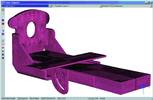
This mesh consists of 109 797 tetrahedral elements. A particular feature of this mesh is the thin plate-like sections. Here, a single element correctly spans the through-thickness direction. Model courtesy of K Walsh Consulting
For the past three years the development team at G+D Computing has been hard at work with this module which consists of a quad-dominant surface mesher together with a tetrahedral solid mesher. Both have been developed and implemented from scratch based on their own research and development. Over the past twelve months the team's efforts in this area have intensified and the current phase of the project is now nearing completion.
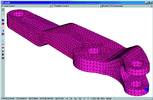
This model of a lever was saved as a SAT file in SolidWorks and imported into Strand7. The surface mesher generated 2468 quadrilateral plate elements. This mesh was fed into the tet mesher which used the quadilaterals to generate 16166 tetrahedral elements
Much of the development work has centred around automatically generating good quality meshes with a minimum amount of user interaction from arbitrary surface data. Both analytical (eg plane, cylinder, cone, torus, sphere) and NURBS surfaces are supported. The meshers also address a number of potential CAD anomalies such as T-junctions (where multiple surface patches meet a single surface patch) and very narrow surface segments. The surface mesher can create both linear (Quad4) and quadratic (Quad8) quadrilaterals. The tet mesher can generate both linear (Tetra4) and quadratic (Tetra10) elements.
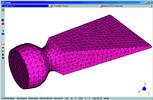
This is a simple CAD model generated as a tutorial in SolidWorks. The surface mesh consists of 1860 triangular elements. The solid mesh consists of 5201 tetrahedral elements
The Strand7 mesher supports the ACIS file format known as SAT for the input of geometry data. The SAT format is currently supported by a number of CAD systems such as AutoCAD and SolidWorks. For simplified geometry, Strand7's own basic geometry input can be used.
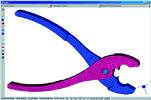
Three parts were automatically meshed to create this model of the pliers, consisting of 12 681 tetrahedral elements
Strand7 Release 2.0 will be available before the end of the year. The launch in South Africa will coincide with the Strand7 developer visiting Johannesburg, Durban and Cape Town in early November.
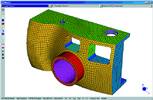
This model is one of the standard AutoCAD surface models. The resulting surface mesh consists of 7822 predominantly quad elements
Allyson Lawless
(011) 476 4100
Others who read this also read these articles
A challenge for motor manufacturers
Computer-based integration of design and manufacturing is essential for the '24-month car' to be achieved[ October 2004 ]
Prominent new lifestyle centre for Cape Town's financial district
Dimension Modeling created the 3D interior models that were then also rendered out for internal views of the apartments as well as the atrium and foyer areas[ August 2004 ]
Anglo Platinum - automating repetitive design tasks with Solid Edge
Solid Edge Insight is an innovative solution that seamlessly integrates CAD, design management and Web-based collaboration into a single tool that is easy to implement and easy to manage[ June 2004 ]
Styled plastic products and packaging - main pains and solution initiatives
To put the product and the customer front and centre, where they belong, all disciplines must sit at the same virtual table, sharing the same information and seeing the same vision[ June 2004 ]
Evolution from 2D to 3D - a product development manager's perspective: Part II
Whereas 2D CAD shortens time scales to some extent, 3D CAD goes much further, directly supporting the whole product development cycle, speeding up every activity and increasing the quality of design by removing many sources of inaccuracy and error[ April 2004 ]
Multiphysics analysis to simulate cylinder head
Adiabatics Inc used multiphysics FEA software from Algor to study the thermal and structural behaviour of a cylinder head for a diesel engine that would provide reduced heat rejection and increased power density while maintaining its superior fuel economy and lower operating cost[ December 2003 ]
Unigraphics NX 2: the next generation
What the NX 2 release sees is the integration of the use of networks of curves to define surface boundaries and existing geometry, and freeform surface modelling into the core of Unigraphics but with a few rather neat extras as well[ October 2003 ]
Geopak helps create Festival City
Geopak Site allows one to handle with ease live 'what if' scenarios with the client and other design team members[ August 2003 ]
Others who read this also read these news items
Lockheed Martin selects preferred MCAD tool
[ December 2005 ]
Grand scale initiatives at Ethekwini Municipality
[ October 2005 ]
Robert Mugabe Avenue in Windhoek gets extension
[ August 2005 ]
Strand7 nonlinear analysis used to solve bracket deformation problem
[ August 2005 ]
Scania optimises truck components
[ February 2005 ]
Delcam's PowerMILL chosen for A1 Grand Prix engine manufacture by Zytek
[ February 2005 ]
A first of its kind: irrigation development, a R3,7-billion SADC project
[ February 2005 ]
Arup lands Tianjin Olympic Aquatic Centre project
[ December 2004 ]
Others who read this also read these regulars
Search Site
Subscribe
Previous Issues
Other Technews Publications
Other Technews Buyers Guides
 |  | Copyright c1995-2009 Technews Publishing (Pty) Ltd.. All rights reserved. |